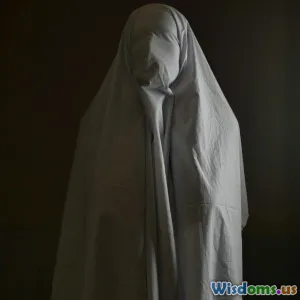
Are Shadow People a Shared Hallucination or Something Else
9 min read Explore the mystery of shadow people: shared hallucinations or something beyond science? (0 Reviews)
Are Shadow People a Shared Hallucination or Something Else?
Shadow people—a phrase that evokes both intrigue and unease within the realms of paranormal lore and popular culture. These elusive, humanoid silhouettes reportedly appear just beyond the edges of vision, often flickering away when directly observed. But what exactly are they? Are shadow people simply shared hallucinations born from human psychology, or do they represent something far stranger — tapping into the supernatural unknown?
This article phenotypically unravels this mystery by contextualizing shadow people within scientific frameworks, examining cultural accounts, and navigating theories from both skeptics and believers.
Defining the Phenomenon: Who are the Shadow People?
Shadow people describe a being or entity typically noticed as dark, shadow-like shapes with vague humanoid form. The common reports involve figures darting across rooms, standing near doorways, or moving along peripheral vision. Witnesses sometimes describe feelings of doom, dread, or an unsettling presence tied to such encounters.
These phenomena have been documented across continents and cultures — from European folklore’s “shadow beings” to the Native American “Skinwalkers” or other spirits in folklore called forth in shadowy mentions.
Notably, shadow people have surged into pop culture and paranormal conversation since the late 20th century, with an influx of anecdotal online testimonies and independent investigations intensified by the rise of night-vision cameras and ghost hunting shows.
Scientific Explanations: Are Shadow People Just Shared Hallucinations?
The Psychology of Perception and Hallucination
One dominant scientific explanation suggests shadow people are hallucinations triggered by the brain’s interpretive processes under stress or sleep states. For example, hypnagogic hallucinations occur at the twilight of wakefulness and sleep and often include seeing shadowy figures. A well-documented phenomenon linked to this is sleep paralysis, where individuals awaken unable to move and perceive a threatening presence — often manifested as a shadowy figure.
Dr. Brian Sharpless, a clinical psychologist specializing in sleep disturbance and hallucinations, notes, "Such figures are largely products of the human mind, influenced by cultural fears and prior experiences." The brain tries to make sense of ambiguous stimuli, creating recognizable figures out of shadows or peripheral distractions.
Collective Cognitive Influence
The notion of shared hallucinations indicates psychological and social dynamics where multiple unrelated individuals report similar entities or visions. This can arise from cultural storytelling, media consumption, or a universal human tendency to pattern-match in ambiguous visual contexts. For example, Pareidolia—the instinctive tendency to perceive meaningful patterns like faces in random objects—may extend collectively into shadow people sightings.
Research in cognitive science points out that mass hysteria or group belief can enhance the prevalence of anecdotal reports. While group hallucinations are rare, environmental or neurological triggers shared among people (such as low-frequency sounds or electromagnetic fluctuations) have been proposed to induce similar hallucinatory experiences.
Neurological and Environmental Contributions
Some studies explore the role of infrasound—low-frequency sounds below human hearing range—in causing feelings of unease and visual misperceptions. Research by Vic Tandy in the 1990s demonstrated how infrasound can induce anxiety and sometimes visual disturbances, potentially explaining historic haunted locations rich in environmental triggers.
Similarly, temporal lobe epilepsy and other neurological conditions have been correlated with reports of apparitional figures resulting from abnormal brain activity. This neurological basis provides a physiological platform for why some individuals consistently experience shadowy presences.
Paranormal Perspectives: Are Shadow People Something Else?
Spiritual Entities or Interdimensional Visitors?
Many believers argue these shadow people are not mere illusions but manifestations of spirits, ghosts, or interdimensional beings. Paranormal researchers describe them as conscious entities capable of interaction and sometimes attributed to negative energy or malevolent intent.
Some parapsychologists hypothesize shadow people could be time travelers or entities crossing into our dimension temporarily, explaining their fleeting presence and resistance to direct observation. Carl Jung's archetype theory suggests they could be collective unconscious projections, given tangible form through shared symbolism of the shadow self.
Historic and Cross-Cultural Accounts
Historical records from various cultures reference encounters with dark, shadow-like figures. For example, the “Hat Man” — a shadow person archetype often visualized wearing a wide-brimmed hat — appears in modern folklore and is frequently mentioned by sleep paralysis sufferers worldwide. Its ubiquity suggests an archetypal component cutting across cultures.
Paranormal investigator Loyd Auerbach contends, "Shadow people sit at a crossroads of belief, psychology, and cultural narrative." He emphasizes that many ghost hunting videos hint at figures not explainable by current technology or common psychological models.
Real-World Cases and Noteworthy Examples
Nancy’s Shadow Visitors
Countless personal testimonies—like that of Nancy, a midwest resident who experienced repeated shadow people during sleep paralysis episodes— show the intersection between neurological events and terror. Nancy’s dramatic experience involved detailed shadow humanoids interacting with her environment, further reinforcing the emotional and psychological impact.
Video Evidence and Skepticism
In recent years, paranormal investigators have released footage claiming encounters with shadow people. While haunting, many such recordings succumb to criticism concerning digital artifacts, pareidolia, or intentional hoaxes.
An investigative report by the Skeptical Inquirer magazine highlighted how shadows cast by passing cars or natural light often mimic humanoid movements — raising alarms about jumping to supernatural conclusions.
Conclusion: A Mystery at the Margin of Science and Belief
Are shadow people merely shared hallucinations crafted by evolutionary brain tricks and neurological anomalies, or do they belong to an elusive, unknown realm awaiting scientific validation? The answer likely reflects a confluence of both psychological phenomena and cultural narratives.
Scientific evidence leans heavily on perceptual errors, sleep states, and environmental stimuli, plausibly explaining much of the shadow people phenomenon. However, the persistence of these sightings and their consistent symbolic imagery across centuries invites an openness to wider metaphysical possibilities.
For the curious, the phenomenon of shadow people offers a fascinating intersection of human cognition, cultural storytelling, and the impulse to uncover what lies beyond the obvious. Whether you approach with skepticism or intrigue, shadow people represent a profound question about the nature of reality and human perception.
References
- Sharpless, B. A., et al. (2013). Paranoia, Hallucinations, and Sleep Paralysis Across Cultures. Journal of Sleep Research.
- Tandy, V., et al. (1998). Infrasound and Its Role in Human Perception. Journal of the Acoustical Society of America.
- Auerbach, L. (2011). Ghost Hunting: True Stories from the World's Most Famous Demonologist.
- Persinger, M.A. (1987). Neuropsychological Bases of Spiritual Experiences. American Journal of Psychiatry.
Whether trapped in the subtle interplay of mind and matter or glimpsing shadows cast from beyond, shadow people remain one of the most compelling mysteries of human experience.
Rate the Post
User Reviews
Popular Posts





















